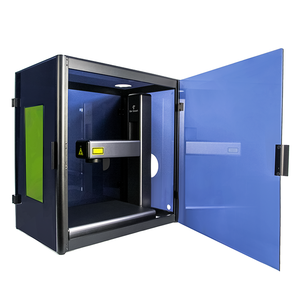A proper laser engraver enclosure is essential—not optional—for every desktop laser engraver. It shields you from harmful infrared or visible beams, captures hazardous fumes, and helps maintain engraving quality.
This guide dives into what makes an enclosure truly safe: mandatory standards, specific performance thresholds, real-world examples like EM‑Smart, and even DIY options if done correctly.
Why Laser Enclosures Are Critical
Laser engravers that use powerful beams—like 20W fiber or diode lasers—can cause serious eye damage or start fires if not properly contained. A certified laser enclosure acts as a Class 1 safety housing, which means it completely blocks any laser radiation from escaping and keeps exposure below safe levels (known as Maximum Permissible Exposure, or MPE).

According to safety standards like ANSI Z136.1 (U.S.) and IEC 60825‑1 (international), all Class 3B and Class 4 lasers—including most 20W desktop machines—must be enclosed or installed in a protected environment to be operated safely.
Key Features to a Laser Enclosure
A reliable laser enclosure must meet specific measurable safety and performance standards. Below are the essential specifications based on internationally recognized guidelines:
| Feature | Recommended Standard / Value |
|---|---|
| Safety Interlock Response | Shut off laser in < 0.3 seconds (IEC 60825‑1; Lasermet) |
| Optical Density (OD) Window | OD5+ for fiber lasers (~1064 nm); OD3+ for diode lasers (~450 nm) (ANSI Z136.1) |
| Ventilation Flow Rate | ≥ 500 m³/h airflow (ISO 14644; Lasermet industrial safety design) |
| Clearance / Fit Allowance | Enclosure should extend 1–2 inches beyond work area for airflow and beam containment |
| Certifications Required | CE (Machinery Directive), ANSI Z136.1, or IEC 60825‑1 compliance |
These figures are validated through authoritative safety references. Any enclosure that does not meet these criteria cannot be considered safe for regular laser engraving tasks.
Enclosure Types You’ll Encounter
Understanding enclosure types is central to choosing the right safety setup for your laser engraver. Especially for 20W fiber and diode desktop machines, the type of enclosure impacts not only safety but also usability, maintenance, and ventilation performance.
Modular (Standalone) Enclosures

Modular or standalone enclosures are separate protective housings designed to surround your laser engraving machine.
These systems typically use an aluminum frame combined with flame-retardant panels and OD-rated viewing windows. The structure allows for airflow channels, exhaust vents, and component access, making them especially suitable for fiber lasers that require strong heat and smoke management.
EM‑Smart’s foldable enclosure is a textbook example. It’s CE-certified, built for 20W desktop fiber lasers, and includes designated ports for ventilation, interlock integration, and visibility without exposure risk.
Integrated (All-in-One) Enclosures

Integrated enclosures are built directly into the laser engraver’s architecture. Machines like the EM‑Smart Dual feature spring-loaded lids with built-in safety interlocks, OD-rated viewing panels, and internal air routing. These enclosures are plug-and-play and require no assembly, making them ideal for users who value speed and simplicity.
However, integrated systems may offer less ventilation customization compared to modular designs. For beginners who prioritize ease of use over DIY flexibility, integrated enclosures are a reliable choice.
DIY Laser Enclosures: A Smart Alternative?
Yes, you can build your own laser enclosure—but only if you understand the risks and safety needs.
If you plan to make one, the required materials should include: fire-resistant boards (e.g., MDF with flame-retardant treatment), aluminum frames or L-brackets, tinted polycarbonate or OD-rated safety film for viewing panels, plaint acrylic is not recommended and PC fans, inline duct fans, or activated carbon filters for airflow.
Make sure your laser engraver enclosure is a fully enclosed box—no gaps for beam leakage, hose port or fan vent for smoke extraction. If possible, make a door switch interlock to connect to your laser's mainboard.
DIY is often more affordable, but not easier. For those with technical confidence, it allows flexibility in size and layout. If unsure, a ready-made, certified enclosure like EM‑Smart’s is the safer starting point.
FAQs for laser enclosure
Can I skip the enclosure if I only use lasers < 20watt?
No. Even 5w diode lasers can emit light reflections or generate smoke that's hazardous to breathe. Enclosures reduce both risks significantly.
Are DIY enclosures safe?
They can be—if built correctly. Just be sure to use flame-resistant materials, block laser wavelengths, and ensure proper ventilation.
What is a laser enclosure?
Frankly speaking, a box to prevent laser beams or related damage like light or toxic gases. Of course, with certifications.
Do you need an enclosure for a laser cutter?
Yes, any laser engraving processing should be done better in a laser safety enclosure.
Can I use clear plastic for visibility?
What’s the key difference between fiber and diode setup requirements?
Conclusion
The laser itself is only half your gear—a properly built, certified enclosure is what makes operation safe.
Certified products, like EM‑Smart's offerings, deliver these specs. DIY is possible—but only if you meet every criterion. Protect your vision, lungs, and workspace by choosing a laser enclosure that handles real-world risk, not just appearance.



1 comment
I updated terms and conditions and now my laser will not mark due to “door not closed” error. My EM-Smart SN20221104M1G02E does not utilize a door.
How can I correct this error?
Thank you – Aaron